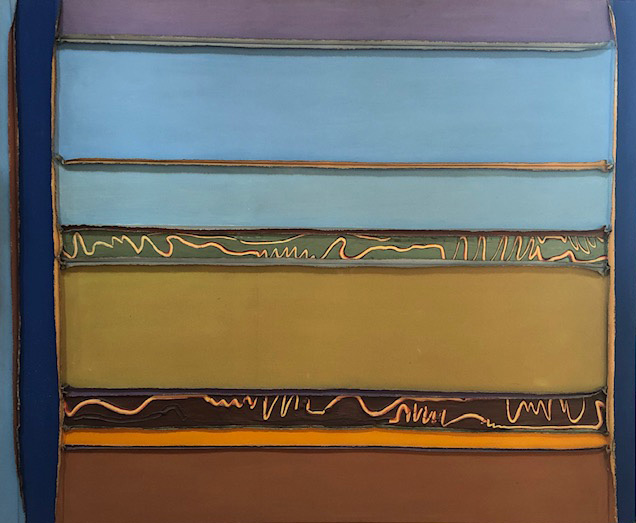Emily Fuller was born in New York City. As a toddler her parents moved to Laurel Hollow, Oyster Bay, Long Island. As a child she loved roaming in the surround woods riding her bike on the quiet roads to visit friends. Her parents kept chickens a few ducks, and turkeys. They planted flowering dogwood trees, rhododendron, laurel, azalea bushes, perennial flower beds, and a vegetable garden. These gardens made her very aware and interested in color and texture.
As a child, a huge influence on Emily was her grandmother, Lucy Washington Hurry, an artist active between 1910-1950. She was a locally known Long Island still life watercolorist, who exhibited and sold her work. Her studio, a separate building in her garden, was a fascinating place filled with props for her still life painting. She had several 19th Century child size boat models hanging from the rafters. Props she used in her still life painting were 19th Century wooden sailing ship name plates, duck & goose decoys, antique costumes, material, band boxes, and Oriental export china. She was very dedicated and painted in her studio every morning from 9-12:30pm. Nobody was allowed to disturb her, no phone calls, nothing.
Along with her grandmother’s artistic influence, Fuller’s interest in making art developed as a result of the positive comments of her teachers throughout her elementary and high school attendance. Art became her most important contribution at school in science, and on the school paper. Emily was taught to draw still life and paint with oil paint on canvas at the Oldfields School, Glencoe, Maryland where she began to feel comfortable painting in oils
Fuller graduated from Garland Junior College (now part of Simons University in Boston) where all students, in order to fulfill the degree requirements, had to earn one semester’s credit by taking the sewing course. Emily found she was good at sewing and liked it so much she took sewing for 2 years. She started making all her clothes when her mother gave her a portable Singer sewing machine. She became more involved in painting and decided to go to the School of the Museum of Fine Arts in Boston, otherwise known as the Boston Museum School. There she majored in painting and took a BS in art education from Tufts University.
After graduating from Tufts Fuller moved to New York where she found work at The Museum of Modern Art clerk typist. While working at MOMA as a secretary to the Elaine Johnson, Director and curator in the Drawings Department collection, she came into daily contact with curators, architects and artists who brought their work in to show the curatorial staff. In 1968 she decided to go back to study painting after work at night. She studied with Richard Mayhew at the Art Students League where she made abstract stained landscapes in the style of pioneering artist, Helen Frankenthaler. Emily’s acrylic stain landscapes had vivid jarring colors & shapes.
In 1971-72 Emily started to sew canvas and make large abstract acrylic landscape paintings. She thought of these paintings as landscape maps with horizontal panels of different depth sewn together and a narrow vertical on one or both ends. She was influenced by Jasper Johns’ maps of the United States and the world that she saw at MOMA.
Fuller bought an industrial Singer sewing machine to sew the canvas and the paper pieces she started to do in 1978. These pieces were made of cold pressed paper sewn together, layer on layer. The cold pressed paper had rough surface reminded her of handmade paper. After a piece was sewn together, Fuller marked the surface with sharp wood cutting tools. The whole piece was painted in acrylic wash with the marks highlighted darker on the scared surface. |
|
 Map Landscape 11
60 x 73"
May–June 1971
Collection of Raynor and Ranne Warner |
The markings were shorthand for trees, vegetables planted in rows, and animal tracks made in the landscape. Then the paper pieces began to develop into windows with shutters, becoming triptychs, with the window in the middle and 2 shutters, one on either side of the middle.
After 1981 Fuller started making more realistic representations of landscape. To acquire more technical skill in representation, she studied with John Alexander Parks at The School of Visual Arts.
During the decade of the 1990’s Fuller has painted direct representation on site, mostly in northeastern Dutchess County, New York, where there is a great deal of land used for agrarian purposes and farm buildings. Area farmers’ alternate crops in twenty-forty horizontal rows of corn and alfalfa planted in horizontal bands across the hills of the area. Having been an abstract painter at one time, these repetitious horizontal blocks of color and texture are appealing to me as subject matter. Water was another interest. Dutchess County if full of streams, creeks, and rivers with rushing water that fascinate.
Favorite times of year to paint outside were in the crop cycle of spring, summer, and fall, April through October. In spring the hillsides are earth colored, before the corn comes up and partly green from quick growing alfalfa. Summer brings fully matured crops, and fall has rows of dried corn stalks that will be chopped up into winter feed for cattle, called silage.
Fuller always takes photographs of what she painted on site. In the winter she relies on the last summer’s photographs for subject matter for collage. During the fall and winter part of the year she returns to making marked paper, sewn canvas mixed media work that combines acrylic paint with photographs. These works are small in scale.
Most recently since the Pandemic Fuller has been taking photographs from newspapers, magazines, and the internet to paint interesting portraits. These portraits range from unknown people to rapper artist (Montero Lamar Hill) aka Lil Nas X, Emily Bronte, writer, and Jeff Wright, writer, comedian actor.
– Emily Rutgers Fuller 2021
|
